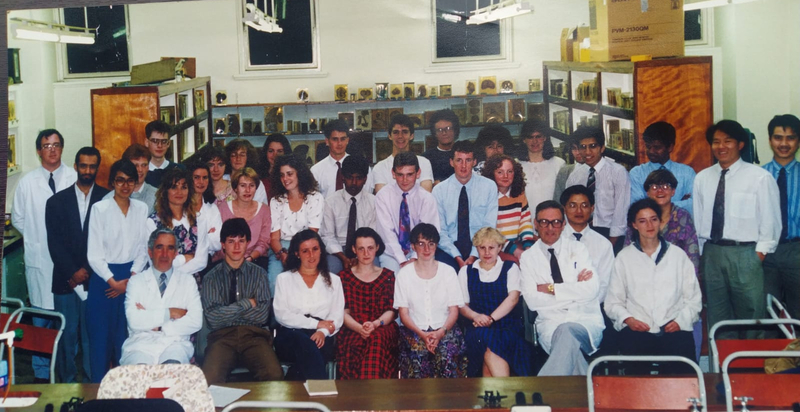Old Pathology Museum, NUI Galway
Item
Format
JPEG
Title
Old Pathology Museum, NUI Galway
Identifier
VH0034
Depiction
A group of thirty-six people in a room with display cases.
Description
Among those pictured in the front row are Professors John Flynn (1st from l.) and Eugene ('Gene') Connolly (2nd from r.).
The old Pathology Museum housed a medical collection of specimens used for familiarizing students with a range of pathological conditions. It was closed when the display of human body parts became controversial.
The origin of the museum dates back to the early decades of the Queen's College Galway. In 1859 the University acquired the Montgomery Collection 'containing over 600 specimens relating to the pathology, anatomy and physiology of the reproduction system' ('A History of the College of Medicine'). It followed the creation, in 1851, of a museum for natural history and geology.
Known as the Museum of Human and Comparative Anatomy, the early collection was organised by the Foundation Professor of Anatomy and Physiology, Professor Charles Croker King (Murray, 1999). In addition to this, the Medical Museum contained a Pathology section.
In 1914 the Pathology Department was relocated to the top of the Engineering Building, just north of the tennis courts. It comprised a students' laboratory, a research laboratory and the museum with its growing collection of specimens.
These and other museums in the Queen's Colleges played a central role in science education in the 19th century, for the benefit of both students and the 'inquiring public'. In the early days they 'also demonstrated to visitors that intellectual culture had arrived in provincial Ireland' (Adelman, p. 4).
The old Pathology Museum housed a medical collection of specimens used for familiarizing students with a range of pathological conditions. It was closed when the display of human body parts became controversial.
The origin of the museum dates back to the early decades of the Queen's College Galway. In 1859 the University acquired the Montgomery Collection 'containing over 600 specimens relating to the pathology, anatomy and physiology of the reproduction system' ('A History of the College of Medicine'). It followed the creation, in 1851, of a museum for natural history and geology.
Known as the Museum of Human and Comparative Anatomy, the early collection was organised by the Foundation Professor of Anatomy and Physiology, Professor Charles Croker King (Murray, 1999). In addition to this, the Medical Museum contained a Pathology section.
In 1914 the Pathology Department was relocated to the top of the Engineering Building, just north of the tennis courts. It comprised a students' laboratory, a research laboratory and the museum with its growing collection of specimens.
These and other museums in the Queen's Colleges played a central role in science education in the 19th century, for the benefit of both students and the 'inquiring public'. In the early days they 'also demonstrated to visitors that intellectual culture had arrived in provincial Ireland' (Adelman, p. 4).
People
John Flynn
Charles Eugene ('Gene') Connolly
References
Personal communication: Charles Eugene ('Gene') Connolly
Juliana Adelman, 'Communities of Science. The Queen's Colleges and scientific culture in provincial Ireland, 1845-1875' (PhD, NUI Galway, 2006). Chapter 5 'Improving museums: showcases of the natural world in provincial Ireland'.
'A History of the College of Medicine, Nursing & Health Sciences at NUI Galway', at https://stories.nuigalway.ie/a-history-of-medicine--at-nui-galway-/index.html. Accessed 8 July, 2023.
James P. Murray, 'Medicine' in Tadhg Foley (ed.), From Queen’s College to National University (Dublin, 1999), pp 142-58.
Contributor
Bibliographic Citation
C.E. Connolly, J. Conroy, ‘Old Pathology Museum, NUI Galway’, Visual History Retired Staff Collection, University of Galway Digital Collections, Asset Id 13756, Archival Record Id VHRS
Spatial Coverage
Category
colour
group
on-campus
indoors
Language
English
Publisher
University of Galway Library
Rights
This image may be used for non-commercial purposes under CC BY-NC-SA see https://creativecommons.org/licenses/by-nc-sa/4.0/

